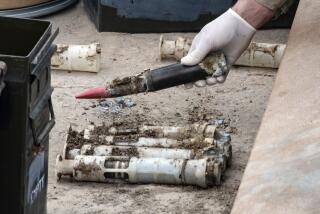‘Balkan Syndrome’ Doubt
- Share via
A number of NATO members fear there may be a link between cancers that have shown up in a small number of the troops who served in the Balkans in the 1990s and American use of depleted uranium munitions in the Bosnia and Kosovo conflicts. In Bosnia in 1994-95, Air Force A-10 tank-hunting planes fired about 10,800 shells tipped with depleted uranium at Serb armored vehicles. In Kosovo in 1999, about 31,000 so-called DU shells were fired. Depleted uranium munitions have been in the U.S. arsenal for about a quarter-century. A byproduct of the ore processed for power reactors and nuclear weapons, depleted uranium is the heaviest metal known and highly effective in penetrating armor.
Whether it is otherwise dangerous is another matter. The Pentagon says depleted uranium is 40% less radioactive than the ore found in nature. A Rand Corp. survey of the medical literature concluded that researchers “do not find any adverse health effects . . . related to radiation from depleted uranium.” The Bulletin of the Atomic Scientists, writing of the more than 900,000 DU shells fired during the 1991 Persian Gulf War, found that the radiological effects from exposure to DU are “too small to be detectable. Given that, radiation from DU is highly unlikely to have been responsible in any way for . . . Gulf War syndrome.” The biggest risk could be kidney problems caused by inhalation or ingestion of the heavy metal. But there is no evidence of an unusual incidence of renal disease among Persian Gulf veterans.
The apparent lack of a connection between DU and serious illnesses has not alleviated concerns among some Europeans. Italy has been looking into the illnesses of 30 of its soldiers who served in the Balkans, seven of whom died of cancer, including five cases of leukemia. Four French soldiers are being treated for leukemia, and one Spanish soldier has died from the disease, though the Madrid government says it does not believe that DU was the cause of the illness. In fact, experts think it’s too soon for any cancers now being detected in Balkan veterans to be linked to DU. A connection, if any, would probably take decades to show up.
Britain has scrutinized the health histories of troops that served in the Persian Gulf War and troops that did not and found virtually no differences. Of the 53,000 British troops sent to the gulf a decade ago, 452 had died by last June, 158 from disease. In a comparable group that did not serve in the gulf, 439 died, 190 from disease. Cancer deaths in the gulf group were slightly lower than in the non-gulf group.
Other countries have been slow to make such comparisons, which are essential to establish causality. Before any linkage between cancer and possible exposure to DU can be credibly suspected, the cancer rate among Balkan veterans must be compared with the rate among those in the same age group--military or civilian--who were never exposed to DU. At this point, as the World Health Organization, NATO and the U.S. government all have said, there is no proof that any link exists between DU and leukemia and other cancers.
But possible health risks cannot be dismissed. The soil of Bosnia and Kosovo contains about 12 tons of DU from U.S.-launched weapons, most of it now probably in powdered form that has leached into the ground. At a minimum, close monitoring of those sites is needed. But also needed is greater restraint among European political leaders who perhaps have been too quick to reach alarmist conclusions about the source of the illnesses affecting a handful of their soldiers. The evidence to date does not support their concerns.
More to Read
Sign up for Essential California
The most important California stories and recommendations in your inbox every morning.
You may occasionally receive promotional content from the Los Angeles Times.













